Cheryl Murray, a woman from Glasgow, Scotland, lived with an undiagnosed lump on her foot for nearly a decade. What began as mild discomfort during her teenage years eventually grew into a serious medical condition that would change her life permanently.
Only after encouragement from her partner did Cheryl seek medical attention — leading to a diagnosis of sarcoma, a rare type of cancer. Her experience serves as a compelling reminder of the importance of early medical evaluation and self-advocacy in healthcare.
A Decade of Silent Struggle
Cheryl first noticed a small, firm lump on the top of her foot at the age of 15. At the time, her symptoms were mild, and an initial medical evaluation attributed the discomfort to a possible soft tissue injury. She was referred for physiotherapy, and no further tests were pursued.
Over the years, the lump gradually grew in size. Though she experienced increasing pain, especially when pressure was applied, Cheryl continued to live with the condition. Due to a combination of embarrassment and uncertainty, she avoided follow-up appointments.
“I felt self-conscious about the lump and kept hoping it would go away on its own,” Cheryl shared in an interview with the Daily Mail.

A Turning Point: Partner Intervention
It wasn’t until Cheryl moved in with her long-time partner, David, that the lump became more difficult to hide. He noticed the swelling and encouraged her to seek medical attention.
“David asked me directly about the lump on my foot,” she said. “I told him it was just torn ligaments, but he didn’t believe that was the full story.”
David’s concern prompted Cheryl to book a new appointment with her doctor. She underwent a full evaluation, including MRI imaging, X-rays, and a biopsy, which confirmed that the mass was a sarcoma, a type of soft tissue cancer.

Understanding Sarcoma
Sarcoma is a group of rare cancers that originate in the body’s connective tissues, such as muscles, tendons, fat, nerves, and blood vessels. According to the Cleveland Clinic, sarcomas account for less than 1% of all adult cancers and are often difficult to detect in the early stages.
There are over 70 subtypes of sarcoma, with some of the most common including:
- Osteosarcoma – typically develops in the bones
- Chondrosarcoma – arises from cartilage cells
- Ewing’s Sarcoma – usually originates in the bone or soft tissue
Sarcomas can occur anywhere in the body but are most frequently found in the arms and legs. The National Cancer Institute states that early detection is crucial, but symptoms can be subtle.
Common signs include:
- A lump or swelling that increases in size
- Persistent or unexplained localized pain
- Reduced mobility or muscle function
- Changes in walking patterns or limb strength
- Visible deformity in the affected area
Because sarcoma can closely resemble benign conditions like cysts or muscle injuries, it is often misdiagnosed without thorough imaging and biopsy.

A Life-Changing Diagnosis and Decision
Following the diagnosis, doctors informed Cheryl that the cancer was aggressive and required immediate surgical intervention to prevent further spread. The medical team recommended amputation of the lower leg as the most effective course of action.
Despite the life-changing nature of the surgery, Cheryl said she felt supported by her partner throughout the entire process. Just weeks before the scheduled amputation, David proposed — a gesture she described as giving her the strength to move forward.

Recovery and Resilience
Cheryl underwent successful surgery and began the rehabilitation process shortly thereafter. She was fitted with a prosthetic limb and began physical therapy to regain strength and mobility.
Her story has since been shared across social media and health blogs, not to evoke pity, but to raise awareness about early detection and self-advocacy in healthcare.
“If I had gone to the doctor sooner, I might not have needed such a drastic procedure,” Cheryl said. “But I’m grateful that I finally got the diagnosis and treatment that saved my life.”
Lessons from Cheryl’s Experience
Cheryl’s journey provides a number of valuable lessons, particularly for individuals experiencing unexplained symptoms. Medical experts emphasize that not all persistent pain or lumps are benign, and any ongoing swelling or discomfort should be properly evaluated.
According to the American Cancer Society, early diagnosis greatly increases the chances of successful treatment for sarcomas and other soft tissue cancers.
If you experience:
- A lump that persists or grows over time
- Pain that doesn’t respond to conventional treatment
- Swelling without a known injury
- Loss of function or sensation in a limb
… it is crucial to consult a healthcare professional. If a diagnosis doesn’t feel right, patients are encouraged to seek a second opinion, particularly if symptoms worsen or do not improve.

What Causes Sarcoma?
While the exact causes of sarcoma are still being studied, several risk factors have been identified:
- Previous radiation therapy
- Exposure to certain industrial chemicals
- Genetic syndromes such as Li-Fraumeni syndrome or Neurofibromatosis
- Chronic lymphedema
However, many individuals diagnosed with sarcoma have no clear risk factors, making early attention to symptoms even more important.
Cheryl’s Message to Others
Now living cancer-free, Cheryl hopes her story will encourage others to listen to their bodies and advocate for themselves.
Cheryl is also working with local charities and cancer support groups in Scotland to share her journey and spread awareness about rare cancers.
Conclusion: When in Doubt, Get It Checked
Health professionals and advocacy groups agree: early detection saves lives. Cheryl Murray’s experience with sarcoma reinforces the need for timely medical evaluation, even when symptoms appear minor or easy to dismiss.
Her story is not only about a health crisis—it’s about the strength to face the unknown, the importance of support systems, and the courage to take control of one’s health.
Sources:
- Cleveland Clinic: Sarcoma Overview
- National Cancer Institute: Soft Tissue Sarcoma
- American Cancer Society: Signs and Symptoms of Soft Tissue Sarcomas
- Daily Mail Interview with Cheryl Murray (2025)
- NHS Inform Scotland: Soft Tissue Sarcoma Information
